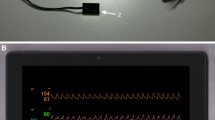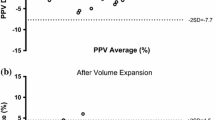Abstract
Objective
To evaluate the clinical performance of a new, continuous intra-arterial blood gas monitoring system (CIABG) in abnormal ranges of blood gases, and during episodes of low blood pressure, in critically ill patients.
Design
Prospective study.
Settings
Medical ICU, University Hospital.
Methods
The CIABG system, based on fluorescent dyes, consists of a fiber-optic sensor introduced through an arterial catheter. Twenty-one sensors were evaluated in 15 acutely ill patients. A high failure rate (6/21) was found, due to the brittleness of the fibers. The bias, between CIABG and standard method, and precision were determined for each fiber and for the overall values. Analysis focused on the data collected in patients with arterial oxygen tension (PaO2) values below 75 mmHg, pH lower than 7.35 and arterial carbon dioxide partial pressure (PaCO2) values exceeding 50 mmHg and during episodes of low blood pressure. The accuracy of the CIABG to follow sequential changes in blood gases was studied among the abnormal values.
Results
Measurements with CIABG among the abnormal values showed biases of +2 mmHg, +0.1 mmHg and +0.005 for PaO2, PaCO2 and pH, respectively, and precisions of 9.0 mmHg, 3.5 mmHg and 0.027, respectively. Bias and precision were not influenced by hemodynamic instability. A substantial difference in the performance of individual CIABG was observed for PaO2 analysis, with 30% of the fibers having a much poorer performance than the others. The sensors were kept in place for 5±2 days and the drift rate per day was 0.005 for pH, 0.6 mmHg for PaCO2 and −1.2 mmHg for PaO2.
Conclusion
In situations of severe hypoxemia, hypercapnia and acidosis, the agreement between CIABG and arterial blood sampling (ABS) is better for PaCO2 and pH than for PaO2, and is not influenced by episodes of low blood pressure.
Similar content being viewed by others
References
Mahutte C (1994) Continuous intraarterial blood gas monitoring. Intensive Care Med 20:85–86
Smoller B, Kruskall MS (1986) Phlebotomy for diagnosis laboratory tests in adults. Pattern of use and effects on transfusion requirements. N Engl J Med 314:1233–1235
Raffin T (1986) Indications for arterial blood gas analysis. Ann Intern Med 105:390–398
Mahutte C, Holody M, Maxwell T, Chen P, Sasse A (1994) Development of a patient-dedicated, on-demand, blood gas monitor. Am J Respir Crit Care Med 149:852–859
Shapiro B, Mahutte C, Cane R, Gilmour I (1993) Clinical performance of a blood gas minotor: a prospective, multicenter trial. Crit Care Med 21: 487–494
Mahutte C, Sasse A, Chen P, Holody M (1994) Performance of a patient-dedicated, on-demand, blood gas monitor in medical ICU patients. Am J Respir Crit Care Med 150:865–869
Zaloga G (1990) Evaluation of bedside testing options for the critical care unit. Chest 97 (Suppl):1855–1905
Thorson S, Marini J, Pierson D, Hudson L (1983) Variability of arterial blood gas values in stable patients in the ICU. Chest 84:14–18
Shapiro B, Cane RD (1989) Blood gas monitoring: yesterday, today and tomorrow. Crit Care Med 17:573–581
Severinghaus J, Naifeh KH (1987) Accuracy of response in six pulse oximeters to profound hypoxemia. Anesthesiology 67:551–558
Barker S, Hyatt J (1991) Continuous measurement of intraarterial pH, PaCO2 and PaO2 in the operating room. Anesth Analg 73:43–48
Greenblott G, Tremper K, Barker J, Gerschltz S, Gebrich J (1991) Continuous blood gas monitoring with an intraarterial optode during one lung anesthesia. J Cardiothorac Vasc Anesth 5:365–367
Mahutte C, Sassoon C, Muro J, Hansmann D, Maxwell T, Miller W, Yafuso M (1990) Progress in the development of a fluorescent intravascular blood gas system in man. J Clin Monit 6:147–157
Larson C, Vender J, Seiver A (1994) Multi-site evaluation of a continuous intraarterial blood gas monitoring system. Anesthesiology 81:543–552
Murray J, Matthay M, Luce J, Flick R (1988) An expanded definition of the adult respiratory distress syndrome. Am Rev Respir Dis 138:720–723
Rossaint R, Falke K, Lopez F, Slama K, Pison V, Zapol W (1993) Inhaled nitric oxide for the adult respiratory distress syndrome, N Engl J Med 328:399–405
Kiiski R, Takala J, Kari A, Milic-Emili J (1992) Effect of tidal volume on gas exchange and oxygen transport in the adult respiratory distress syndrome. Am Rev Respir Dis 146:1131–1135
Roupie E, Dambrosio M, Servillo G, Mentec H, El Atrous S, Beydon L, Lemaire F, Brochard L (1995) Titration of tidal volume and induced permissive hypercapnia in the acute respiratory distress syndrome. Am J Resp Crit Care Med 152:121–128
Bland J, Altman D (1986) Statistical methods for assessing agreement between two methods of clinical measurement. Lancet 2:307–310
Haller M, Kilger E, Briegel J, Forst H, Peter K (1994) Continuous intraarterial blood gas and pH monitoring in critically ill patients with severe respiratory failure: A prospective, criterion standard study. Crit Care Med 22:580–587
Shapiro BA, Cane RD, Chomka CM (1989) Preliminary evaluation of an intra-arterial blood gas system in dogs and humans. Crit Care Med 17: 455–460
Zimmerman J, Dellinger P (1994) Initial evaluation of a new intraarterial blood gas system in humans. Crit Care Med 21:495–500
Venkatesh B, Clutton Brock T, Hendry S (1994) A multiparameter sensor for continuous intraarterial blood gas monitoring: a prospective evaluation. Crit Care Med 22:588–594
Shapiro B (1994) Blood gas monitors. Justifiable enthusiasm with a note of caution. Am Rev Respir Dis 149: 850–851
Knaus W, Draper E, Wagner D, Zimmerman J (1985) Prognosis in acute organ-system failure. Ann Surg 6: 685–693
Le Gall J, Loirat P, Alperovitch A, Glaser P, Granthil C, Mathieu D, Mercier P, Thomas R, Villers D (1984) A simplified acute physiology score for ICU patients. Crit Care Med 12: 975–977
Author information
Authors and Affiliations
Rights and permissions
About this article
Cite this article
Roupie, E.E., Brochard, L. & Lemaire, F.J. Clinical evaluation of a continuous intra-arterial blood gas system in critically ill patients. Intensive Care Med 22, 1162–1168 (1996). https://doi.org/10.1007/BF01709330
Received:
Accepted:
Issue Date:
DOI: https://doi.org/10.1007/BF01709330




